That is the teaser that appeared at the end of the VHS copy of Raiders, promoting the next Indiana Jones film. It also played in theaters, told you almost nothing about the movie, but whetted your appetite so much that you wanted to stay and watch it again, at least I did. For me, this was the most highly anticipated film of 1984 and it lived up to my expectations. Many have criticized it, some have suggested that it is not worthy, but I am willing to defend it to the end and strongly endorse everyone over the age of 13 seeing it. OK, most of those under 13 as well.
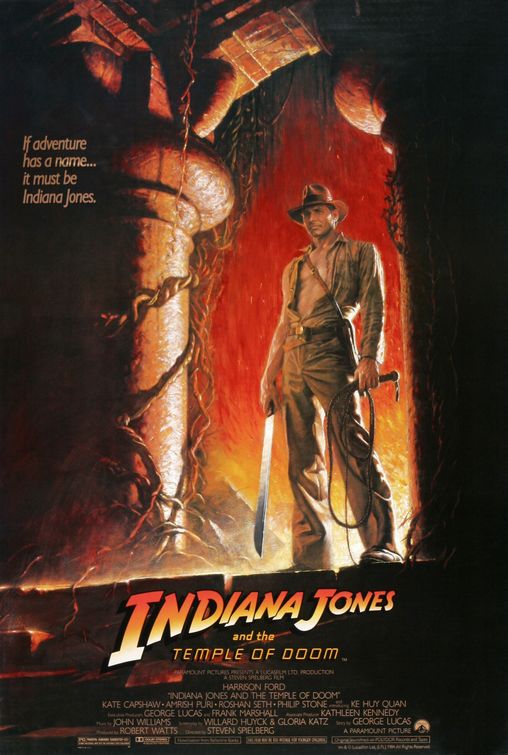 As I write this post, I look out the door of my office and I see hanging on the wall the posters from the Indiana Jones series. This one is a personal favorite. The heroic Dr. Jones, standing in the archway, back lit by flames, with his whip and a machete in his hands. This kicks ass! This movie is important for a number of reasons, and had time not intervened, it could have been possible for the Indiana Jones stories to have careened forward and backwards like the first three did. I have great memories of the movie as well and some of them are a little cool.Willard Huyck and Gloria Katz are the screenwriters of “Indiana Jones and the Temple of Doom”. They had previously been nominated for an Oscar for the screenplay of “American Graffiti” and were doubtless brought to the project by their old friend George Lucas. Their output had been a little inconsistent, but they managed well with this throwback to a Kipling styled adventure that takes place prior to the events of “Raiders of the Lost Ark”. So technically, “Temple of Doom” is not a sequel but a prequel. Much like the “Star Wars” films however, I suspect that not many people feel the need to watch these in the order of chronology. 1984 was a mixed year for the couple, they wrote the second biggest movie of the year and they wrote and Huyck directed one of the biggest bombs of the year, “Best Defense”. Spielberg and the writers will have to take the blame for the criticism leveled at this movie for it’s stereotypes and potentially racist attitude. Given that it was 1984, the film is set in 1935 and it is aping films made from the 30s, 40’s and 50’s, it requires a little tunnel vision to focus on those things that are bothersome and ignore those things that are just part of the tableau for this field.
As I write this post, I look out the door of my office and I see hanging on the wall the posters from the Indiana Jones series. This one is a personal favorite. The heroic Dr. Jones, standing in the archway, back lit by flames, with his whip and a machete in his hands. This kicks ass! This movie is important for a number of reasons, and had time not intervened, it could have been possible for the Indiana Jones stories to have careened forward and backwards like the first three did. I have great memories of the movie as well and some of them are a little cool.Willard Huyck and Gloria Katz are the screenwriters of “Indiana Jones and the Temple of Doom”. They had previously been nominated for an Oscar for the screenplay of “American Graffiti” and were doubtless brought to the project by their old friend George Lucas. Their output had been a little inconsistent, but they managed well with this throwback to a Kipling styled adventure that takes place prior to the events of “Raiders of the Lost Ark”. So technically, “Temple of Doom” is not a sequel but a prequel. Much like the “Star Wars” films however, I suspect that not many people feel the need to watch these in the order of chronology. 1984 was a mixed year for the couple, they wrote the second biggest movie of the year and they wrote and Huyck directed one of the biggest bombs of the year, “Best Defense”. Spielberg and the writers will have to take the blame for the criticism leveled at this movie for it’s stereotypes and potentially racist attitude. Given that it was 1984, the film is set in 1935 and it is aping films made from the 30s, 40’s and 50’s, it requires a little tunnel vision to focus on those things that are bothersome and ignore those things that are just part of the tableau for this field.
The tone is set from the opening credits. Spielberg has yet to do a musical but if he chooses to helm “The Book of Mormon”, you can bet he will make it sparkle. Just look at this image of the Title screen:
 The female lead, played by the future Mrs. Spielberg, appears in front of the titles while the background is behind them. There is an elaborate dance number that will have you wondering if you really have sat down to an Indiana Jones adventure or maybe just fallen through a portal in time to RKO or MGM in the early 1950s. The crowded nightclub vanishes in a plume of red smoke, and two dozen dancers fill a stage the size of Radio City Music Hall. While it is not exactly Busby Berkley, it is impressive and clever. What is really most clever is the choice of song American nightclub singer Willie Scott is singing. It is a Mandarin version of Cole Porter’s “Anything Goes” and it is a clear signal to the audience to be ready for some over the top moments of action and adventure.
The female lead, played by the future Mrs. Spielberg, appears in front of the titles while the background is behind them. There is an elaborate dance number that will have you wondering if you really have sat down to an Indiana Jones adventure or maybe just fallen through a portal in time to RKO or MGM in the early 1950s. The crowded nightclub vanishes in a plume of red smoke, and two dozen dancers fill a stage the size of Radio City Music Hall. While it is not exactly Busby Berkley, it is impressive and clever. What is really most clever is the choice of song American nightclub singer Willie Scott is singing. It is a Mandarin version of Cole Porter’s “Anything Goes” and it is a clear signal to the audience to be ready for some over the top moments of action and adventure.
Although Lucas wanted the film to be darker than the original “Raiders of the Lost Ark”, it has several elements that make it the lightest film in the series at times. True there is torture and murder and kidnapping featured as main plot elements, but there is also a smashing opening sequence with a great deal of laughter, some tongue in cheek action sequences, and a damsel in distress that is played loudly for comic relief. Let’s start with the exchange of the diamond for the remains of the Emperor that Indy is trying to complete. Several reversals occur, some of them tragic, and yet Dr. Jones ends up crawling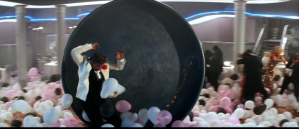 across the floor, searching for his diamond amid spilled ice, and trying to escape being machine gunned by hiding behind a gong that was used to announce the production credits much like the one at the start of “Gunga Din”. Even though Wu Han goes to the next great adventure first, the subsequent mixture of wrong person with the right item, surrounded by confusion and bad guys is still a lot of fun. When the audience discovers that Indy and Willie are escaping from club Obi Wan, the fun becomes exactly the kind of self referential insider joke that geeks around the world love.
across the floor, searching for his diamond amid spilled ice, and trying to escape being machine gunned by hiding behind a gong that was used to announce the production credits much like the one at the start of “Gunga Din”. Even though Wu Han goes to the next great adventure first, the subsequent mixture of wrong person with the right item, surrounded by confusion and bad guys is still a lot of fun. When the audience discovers that Indy and Willie are escaping from club Obi Wan, the fun becomes exactly the kind of self referential insider joke that geeks around the world love. 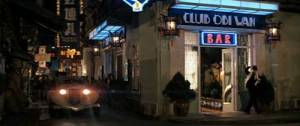 When a ten year old kid pops in and rescues the two by driving a giant luxury car through the streets of the Chinese city, while gun play ensues and the poisoned Dr. Jones cracks wise, it is not hard to tell that this is going to be a go for broke run of two hours of great entertainment. Forget whether the abandonment of a plane in mid air is the best way to take down the pesky archeologist, logic matters less than holding on to your seat and trying to keep up.
When a ten year old kid pops in and rescues the two by driving a giant luxury car through the streets of the Chinese city, while gun play ensues and the poisoned Dr. Jones cracks wise, it is not hard to tell that this is going to be a go for broke run of two hours of great entertainment. Forget whether the abandonment of a plane in mid air is the best way to take down the pesky archeologist, logic matters less than holding on to your seat and trying to keep up.
In 2008, many critics of “Indiana Jones and the Kingdom of the Crystal Skull”, tried to take the older media saying of “jumping the shark” to indicate when a film or TV series has gone past the point of acceptable , into “nuking the fridge”. They could easily have started twenty four years with a phrase like “skydiving the raft”. I’m not sure that surviving an A-bomb test by climbing into a lead lined refrigerator is that much less believable than parachuting out of a plane in an inflatable life raft. Each requires us to laugh at the ridiculous idea but then go ahead and accept it for the purpose of the story. Spielberg lays it on even thicker here though by having Indy and his companions not only survive the fall from the plane, but also a sledding down a mountain, and a second fall almost as far into a river, and then escape through some rapids. That’s a lot of cheek space needed to put your tongue in, but everyone found it in 1984, although they did not in 2008.
“Temple of Doom” features the two least liked characters of the series, at least until the introduction of of Shia LeBeouf’s Mutt Williams. The aforementioned Willie Scott is a shrill and stereotypically air-headed blonde, that Indy has to drag around and make sexual innuendo with. Even though she is much more typically a 1930s female character than Marion Ravenwood, it does not take long for us to tire of her. In part that’s because we are also accompanied by that ten year old mentioned earlier. Short Round is annoying the way any kid character can be in what is largely an adult story. He is there for comic relief, and to provide additional sources of jeopardy. He also allows Spielberg to indulge in the wistful father figure themes he comes back to regularly in his movies. Here he cribs himself from another father-son moment in an earlier masterpiece, Chief Brody in India. I don’t think people hated “Shorty”, but much like Mutt in 2008, it feels like we are dealing with a little domestic drama as we get out dose of adventure.
I don’t think people hated “Shorty”, but much like Mutt in 2008, it feels like we are dealing with a little domestic drama as we get out dose of adventure.
The charges of racism stem mainly from the depiction of the Indian villagers and the villains of the story, a cult of Thuggees worshiping Kali. When Indy and company arrive at the local Maharaja’s palace in Pankot, they are invited to partake in a meal featuring every westerner’s nightmare cuisine from another country. Large juicy beetles are scooped out for their soft insides. A snake is slit open and live eels slither out onto your plate for a wiggling appitiezer.  Eyeballs float to the top of the soup to stare at you as you wonder where your appetite has got to. Oafish Indian men, slurp up the food in a manner resembling a speed eating contest, shoveling bits of bug and eel into their mouths with loud appreciative glee and smirks on their faces as the western guests recoil in horror. The piece de resistance turns out to be chilled monkey brains consumed out of the skulls of the dead monkeys when you pull off the pre-cut scalp off of their heads.
Eyeballs float to the top of the soup to stare at you as you wonder where your appetite has got to. Oafish Indian men, slurp up the food in a manner resembling a speed eating contest, shoveling bits of bug and eel into their mouths with loud appreciative glee and smirks on their faces as the western guests recoil in horror. The piece de resistance turns out to be chilled monkey brains consumed out of the skulls of the dead monkeys when you pull off the pre-cut scalp off of their heads.
This is the stereotyping that got the movie in trouble to begin with. Later, when we meet the main villain of the story, the ethnocentric atmosphere gets even thicker. Swarthy men in turbans whip children into submission. Nearly hypnotized followers in nothing more than a cloth diaper, wave their hands around above their heads, chanting nonsense versions of Hindi phrases and screaming with maniacal glee as human sacrifice is performed in front of them. If any of it was meant to be taken seriously, then people probably have a right to complain. Since it is so clearly over the top and part of an old fashioned “boy’s adventure” type story, the excesses should be easy to dismiss. The outlandish apparel and manners are not really supposed to be a guide to the culture, they are designed to horrify and intrigue us at the same time.
Immediately following the dinner, we get two sequences that show us exactly how exaggerated the movie is. Willie and Indy engage in an extended battle of flirtatious words. each waits for the other to surrender and consummate their romance. It plays out for a stretch to make us feel the moment and to set up the surprise attack that takes place and leads Indy to a secret passage through a booby trapped cavern. 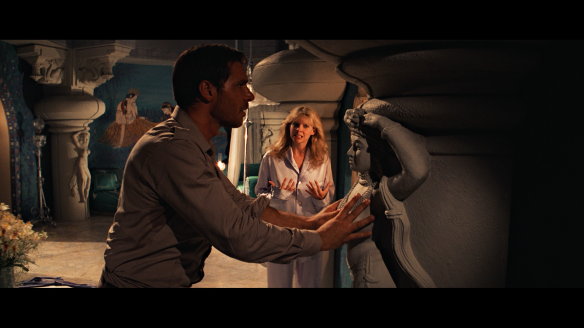 Willie pleads with Indy to notice that he has the wrong set of breasts in his hands, but he has become all business after being attacked. It is a completely silly joke that fits the outrageous nature of this “Anything Goes” movie.
Willie pleads with Indy to notice that he has the wrong set of breasts in his hands, but he has become all business after being attacked. It is a completely silly joke that fits the outrageous nature of this “Anything Goes” movie.
After Indy discovers the secret passage, he and Short Round proceed into the dark part of the movie and ultimately drag Willie out of the plush surroundings she fits in most naturally. This is the sequence that got the biggest rise from the audience. As the two guys walk through the dark passage and we hear the crunching on the ground as their feet move, it is easy to have an ick reflex. Then we get a chance to see some of the bugs that infest the passage and the audience screams. OK, so Spielberg got us with a cheap trick. He doesn’t stop there however. The two get trapped in a circular killing room as the ceiling closes down on them, and they shout back for Willie to come and trip the doortrap and release them. She of course worries about girly things like a broken nail, but we know what is coming. When the audience remembers she is practically barefooted, they start rumbling, but when she finally sees the extremely large critters crawling on her, the audience howled with both laughter and disgust. Well played Mr. Spielberg. Of course the capper comes when she re-engages the booby trap and once again the whole process starts over. I saw this film two days in a row, and on the second day my wife’s good friend sat next to me and she practically lifted her feet into my lap to avoid having them dangle near the floor of the theater, and then grabbed my arm so tight, my wife should have been jealous. I don’t know that the scene plays as well today, but in 1984 it was gangbusters.
The story got complicated at this point, with a human sacrifice, the enslavement of children, a hypnotized Indiana Jones, and a voodoo doll used to help control him. The drama here is heavily influenced by the John Williams score featuring near tribal chanting and Willie screaming in the process. A well staged fight sequence precedes the main set piece of the movie, a mine cart chase though a cavernous mountain, that features carts trading places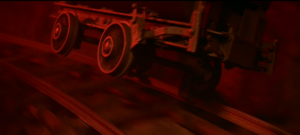 on parallel tracks or catching up on the same track and engaging in swordplay, gunfights and fisticuffs. It is a long sequence and it is full of humor, suspense and action. Critics of “Temple of Doom” for all it’s other perceived faults will usually acknowledge this chase as one of the high points in the Indiana Jones series. Sure there are a number of improbable events, including a jump from a missing span of track to another segment, over what appears to be a sea of lava. You will be laughing so hard and trying to catch your breath that you will not really bother to think about how silly the idea is.
on parallel tracks or catching up on the same track and engaging in swordplay, gunfights and fisticuffs. It is a long sequence and it is full of humor, suspense and action. Critics of “Temple of Doom” for all it’s other perceived faults will usually acknowledge this chase as one of the high points in the Indiana Jones series. Sure there are a number of improbable events, including a jump from a missing span of track to another segment, over what appears to be a sea of lava. You will be laughing so hard and trying to catch your breath that you will not really bother to think about how silly the idea is. 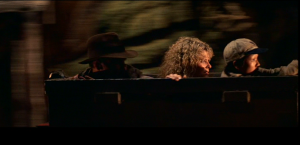 The conclusion of the mine chase is also a bit fantastic, with the villain spilling a giant vat of water down the mine as an attempt to wash away Dr. Jones. Never mind that the cavern is so deep and long that nothing less than a river would be able to flood it, it gives us one last thrill moment in the sequence.
The conclusion of the mine chase is also a bit fantastic, with the villain spilling a giant vat of water down the mine as an attempt to wash away Dr. Jones. Never mind that the cavern is so deep and long that nothing less than a river would be able to flood it, it gives us one last thrill moment in the sequence.
For a little insight into how the sequence was created, I decided to share this ad that ran in Los Angeles area theaters for the LA Times Calendar section. The Times produced dozens of these little vignettes to show they understood how to cover what we in the area refer to as “the business”. This one was clearly inspired by the “Temple of Doom sequence we have been looking at.
The tech used in the film was probably a little different, but you can get a sense of how involved the process was and of course the fact that CGI was basically not used at all in these films. They combined model work, stuns, camera photo effects, rear screen and puppets to get what they needed.
The film also used actual locations in a number of places. The bridge climax takes place on an actual suspension bridge that was located near the site s of filming. It was combined with some of the above mentioned technologies to give us a finish that was a cliffhanger, without leaving us in limbo. The transition between the mine car sequence and the bridge scene involved a great joke that played off of the famous incident in “Raiders” that was basically improvised because Harrison Ford was too sick to shoot the elaborate sword and whip fight that had been planned. It is probably the biggest laugh of “Raiders” when Indiana simply shoots the swordsman and moves on to the next scene. When faced with the same dilemma in facing two sword wielding opponents, Indy reaches for his gun with a cocky smile, until he realizes that the gun is not there. Cocky turns to sheepish in an instant under the efforts of Harrison Ford, who was neglected for Awards consideration mostly because his performance is physical. This one moment showcases his acting talent in the context of this type of movie. 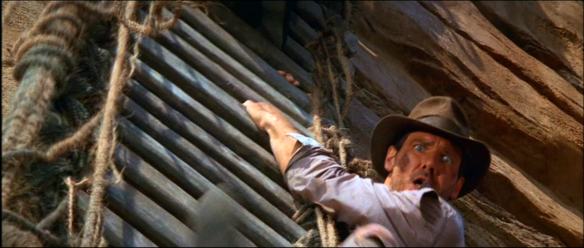 Because so much of an actors performance in a movie like this involves reacting rather than acting, people probably see it as less technically difficult. If that were true, Tom Selleck would have become a bigger action star than he was, even though he missed out on this part. Ford maintains credibility when necessary and can vamp when required. Indiana Jones was a perfect match for his skills.
Because so much of an actors performance in a movie like this involves reacting rather than acting, people probably see it as less technically difficult. If that were true, Tom Selleck would have become a bigger action star than he was, even though he missed out on this part. Ford maintains credibility when necessary and can vamp when required. Indiana Jones was a perfect match for his skills.
It would not make sense to talk about “Temple of Doom” and not mention the fundamental shift in movie making and marketing it resulted in. Like “Jaws”, nine years earlier, “Indiana Jones and the Temple of Doom” is rated PG. That’s right, my wife could technically show those movies to her elementary classes without much worry since no permission from the administrators is required when a film has that mild rating. Of course the movie is not mild at all. Where “Jaws” featured a shark eviscerating a beach community in the summertime, “Temple of Doom” spotlights a man, reaching into the chest of a hapless victim. pulling his still beating heart out of his chest, holding it aloft for all the followers and the victim to see, as the man is then tortured by being lowered into a lava pit and his heart explodes into flame in the hands of the villain Mola Ram.  If this is not enough to give kids nightmares, I don’t know what is. The problem at the time was that the next rating up was R and that seemed to be much more restrictive than anyone thought was necessary. A couple of weeks later, “Gremlins”, which arrived as a Spielberg sanctioned production, added fuel to the fire with several more gruesome sequences in a PG rated movie. Many parents were up in arms and a controversy arose concerning the ratings system. It was Steven Spielberg himself who suggested the PG-13 rating to Jack Valenti and the MPAA. Within a few days it was established and 1984 saw the arrival of the first films with that label (An issue we will discuss later in the summer). The addition of the PG-13 rating has freed a number of film makers from limitations in the ideas they want to put on the screen, but it has equally frustrated as many others because the rating has become a requirement by studios in their production agreements. The most successful films in recent years have been rated PG-13 and studios are looking for the sweet spot in the marketplace. If you ever feel like cursing the powers that be for watering down a tough script in order to get a PG-13 rating, some of the blame will rest on the shoulders of Dr. Jones.
If this is not enough to give kids nightmares, I don’t know what is. The problem at the time was that the next rating up was R and that seemed to be much more restrictive than anyone thought was necessary. A couple of weeks later, “Gremlins”, which arrived as a Spielberg sanctioned production, added fuel to the fire with several more gruesome sequences in a PG rated movie. Many parents were up in arms and a controversy arose concerning the ratings system. It was Steven Spielberg himself who suggested the PG-13 rating to Jack Valenti and the MPAA. Within a few days it was established and 1984 saw the arrival of the first films with that label (An issue we will discuss later in the summer). The addition of the PG-13 rating has freed a number of film makers from limitations in the ideas they want to put on the screen, but it has equally frustrated as many others because the rating has become a requirement by studios in their production agreements. The most successful films in recent years have been rated PG-13 and studios are looking for the sweet spot in the marketplace. If you ever feel like cursing the powers that be for watering down a tough script in order to get a PG-13 rating, some of the blame will rest on the shoulders of Dr. Jones.
While it was impossible for any film to match the perfection that is “Raiders of the Lost Ark”, this prequel does an admirable job in trying. Spielberg has distanced himself from this episode at times, in a way that I think is unjust. Political Correctness is a dangerous thing. Sure we want to be respectful and have a broad audience, but when you hold back too much on the boyish and innocent enthusiasm, you get “Indiana Jones and the Kingdom of the Crystal Skull”. Better to risk being mildly offensive than to end up with a character swinging through the trees with CGI monkeys and playing Johnny Weismueller in the background.
In 1984, this was the “Big” movie of the summer. It was surprisingly passed in box office by another effects laden film a few weeks later, but this was the one everyone knew would be a success. We saw it opening night at the Chinese Theater on Hollywood Blvd., along with the director himself. Spielberg did not speak or appear in front of the audience, but watched instead from the balcony like area above the projection booth. After the film, most of the audience rang out approval with applause and cheers, and most of us looked up at that spot in the back of the theater and hoped we would get more from Spielberg and Dr. Jones.


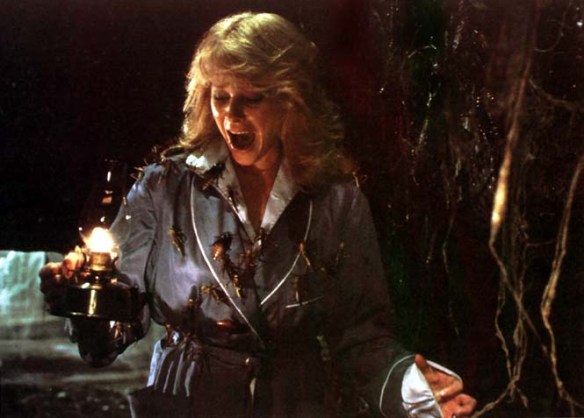

As a child of the 80s part of me longed for an alternate universe where Indiana Jones was as prolific as James Bond, and every other year I could anticipate a new archaeological adventure, Dr. Jones eventually making his way to the Antarctic, or the jungles of Africa or uncovering the mysteries of the Bermuda triangle. Later rather than sooner, Harrison Ford would retire and tip the hat (is it a fedora?) to another 40-something to pick up the whip where he left off and on the series would go.
It may fashionable to dismiss Temple of Doom as only a fantasy, but for me this film is as real, and proper a sequel (prequel) for this character as you can get. Thanks for reviving some dormant memories.
That’s what I wanted for Indy as well, but getting the three within ten years was pretty close. I know that there are novelizations out there that tell those kinds of stories, I just never read them. Glad you had a moment’s nostalgia with me, thanks for visiting.
I LOVE this idea. Picking a year and then reviewing the movies in the order they came out. . I knew 1984 was a great year, but I never realized how great.
Indiana Jones and the Temple of Doom was the 3rd biggest hit of the year. I remember this got some very harsh reviews at the time. Possibly being compared to the extremely high standard of Raiders. Over time I think people have re-evaluated it and now it’s more beloved now than it was at the time. Although it was the 3rd biggest hit of the year so audiences obviously saw it in droves.
I can’t wait till 6/8 when Ghostbusters and Gremlins both came out on the same day!!
Hi Mark, I’m glad you like this idea. It is nostalgia heavy but I also try to be critical as well. You are right, next week will be epic. I hope you will come back regularly. Thanks for the comments.
Pingback: AMC Classic Series: Raiders of the Lost Ark | Kirkham A Movie A Day
Pingback: Gremlins | 30 Years On: 1984 a Great Year for Movies
Temple is certainly the weakest of the three 1980s Indiana Jones films, but it’s still a good movie and a lot of fun. Like most people, my problems are Willie and Short Round, but only mildly; it helps knowing why they were included, as those character types were prominent in the pulp adventure fiction of the 1930s.
I’m glad you called out the fact that these films are aping those old pulps. I think that, more than anything else, is why people had so much of a problem with Crystal Skull: they don’t know enough to realize that. The biggest viewing audience and the loudest complainers for the fourth film were people of my generation. The ones who grew up watching Indy, and — being kids — took the silly things seriously. I eventually did enough reading to realize what the franchise was trying to be, but most people never did. They thought Indiana Jones was a modern adventure series, when it never truly was. It’s pulp fiction with a modern budget, but all of pulp’s sensibilities. India was never like it’s shown in Temple, but that’s how it was shown in 1930s pulp fiction. And surviving a nuke inside a fridge would have been perfectly plausible in 1950s pulp fiction.
But today’s audience does not like, and does not get, pulp fiction. It’s the main reason Crystal Skull got so much heat, and why John Carter failed as well. Yes, both films had some definite flaws. But they weren’t worthy of the derision they received; people were just looking for something different than what they were. And to me, that says more about the audiences than the movies. I have a feeling that if Star Wars were released for the first time today, it would get a similar reaction.
Morgan, I think you hit the nail on the head. Modern audiences reference points are not the pulp stories of the thirties and forties, they are the crime dramas and kung fun epics of the seventies. So Kill Bill and Django work for them but Crystal Skull sucks for doing things just as outrageous but with a older sensibility. You are right about Star Wars also, which makes me worry about the new episode in that franchise. You get the prize for best comment of the week. Sorry, no cash comes with that.
Like the old Marvel No-Prize. 😀
Pingback: Dreamscape | 30 Years On: 1984 a Great Year for Movies
Pingback: Choose Me | 30 Years On: 1984 a Great Year for Movies
Pingback: Beverly Hills Cop | 30 Years On: 1984 a Great Year for Movies
Pingback: Indiana Jones Triple Feature | Kirkham A Movie A Day
Pingback: My Slate of Films from the Spielberg Draft on the Lambcast | Kirkham A Movie A Day